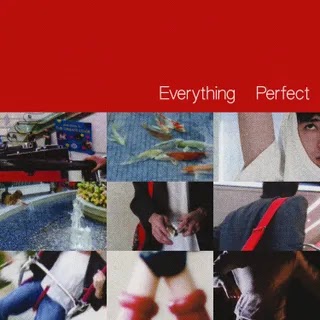Today on Pitchfork, we are taking a critical look at Talking Heads with new reviews of five albums that chart their journey from New York art punks to a voracious and spectacular pop group.
When the Ramones and Talking Heads toured Europe in the spring of 1977, Johnny Ramone was annoyed by seemingly everything. The varieties of lettuce served abroad. Stonehenge (“a buncha rocks,” he called it, according to the excellent book Love Goes to Buildings on Fire). And of course, the James Brown tapes that Talking Heads bassist Tina Weymouth played on the bus. Though the two bands frequently gigged together within the early New York punk scene, the Ramones were all about girl groups and surf rock, while their preppy-looking tourmates—particularly Weymouth and her soon-to-be husband, drummer Chris Frantz—were wild about funky R&B.
Toward the end of the tour, Talking Heads played a small solo show in London. Brian Eno, fresh off making Low with David Bowie, caught the gig and invited the band to lunch the next day, which turned into listening to records at his flat. The producer put on Fela Kuti’s Afrodisiac and blew their minds. Afrobeat music (particularly West African polyrhythms) would become the next big influence on the members of Talking Heads, culminating in their magnum opus, 1980’s Remain in Light. But while that was still percolating, the group made an immediate connection with Eno. By the following spring, Talking Heads had kicked their original production team of disco pros to the curb and took up recording More Songs About Buildings and Food alongside Eno in the Bahamas.
Though many tracks on their second album were live staples dating back to 1975, the songs took on a more groove-oriented sound as Talking Heads progressed and played to their strengths. Incorporating disco rhythms separated them further from Television, their closest corollary in the CBGB scene. The tempos were slowed down and simmering, while the layers of instrumentation and effects were built up. You can hear Eno’s “studio as instrument” approach in all sorts of sonic details, like the loudspeaker-style vocals and reverb bouncing off the drums in “Warning Sign,” the curious clicks and dubby echoes punctuating “Stay Hungry,” or the faint twinkling between lines in the chorus of their heady cover of Al Green’s “Take Me to the River.” But these increasingly intricate aesthetics never threaten to overthrow the music’s pleasure center: an involuntary compulsion to move your body. On More Songs About Buildings and Food, Talking Heads were sorting out how to engage simultaneously with the mind and the soul (or at least the hips)—how to be both art-rock and dance music.
“Take Me to the River,” their first Top 40 hit, is ground zero for this duality. At the time, various white fools were reinterpreting Reverend Green’s 1974 album-cut-turned-Syl-Johnson-hit, ranging from the horrid (Foghat) to the decent (Levon Helm); none of them come near Talking Heads’ singular take. A soul song that walks the line between the sacred and the profane is not something you’d expect a singer who typically yelped quotidian paranoia to excel at, yet David Byrne’s idiosyncratic vocal phrasings—his pauses, his stretched-out crooning and strained falsetto, his “yayayayayaya” that sounds like it’s coming toward you—forever changed the way people hear “Take Me to the River.” And Byrne isn’t even the cover’s main power source, Weymouth is. Their version is one big, throbbing bass loop—the fastest, possibly only route to a sexy Talking Heads song.
Byrne spends much of his band’s most immediately danceable record not getting laid, though. He claims he’s just too busy for romance these days. When he demands, atop a frantic guitar jangle in “The Good Thing,” that you stop and watch him work, it could almost be the album’s thesis statement. But Byrne is not just a workaholic, he’s also humorously jaded: The girls, after all, are “getting into abstract analysis” instead of paying attention to him. The one clear relationship portrait he paints is completely absurd, centering around a couple that funnels their stupid fights into a hit TV show; cheekily, it’s called “Found a Job.” By and large, these songs are about being a young, ambitious artist in the city, an album where the age is forever 26 and the mood is raring to go.
Two songs that epitomize this outlook, “Artists Only” and “The Big Country,” are among the album’s most beautiful—the former for its interlocking parts, the latter for its swooning simplicity. An ode to the creative process, “Artists Only” is built from the kind of instrumental interplay that makes you want to dismantle it just so you can understand the source of its magic and mystery; is it the swirling organ melody, the chiming guitar riff, or the chugging bassline that produces this effect? (Like most things Talking Heads, the magic’s in the combinations.) Meanwhile, “The Big Country” is as lucid (and twangy) as Byrne gets: “I wouldn’t live there if you paid me,” he pronounces outright in the surprisingly laidback chorus. He borrowed the phrase “the big country” from Roxy Music’s Country Life closer “Prairie Rose,” where it refers to Texas, but as far as Byrne’s concerned, it’s any place you’d fly over without feeling much curiosity. It’s a barbed judgement he sings with relative peace, like someone relieved they live amid the move and hustle of New York City instead of, y’know, America.
👉👇You May Also Like👇👌
View the original article here








%20Music%20Album%20Reviews.webp)







0 comments:
Post a Comment